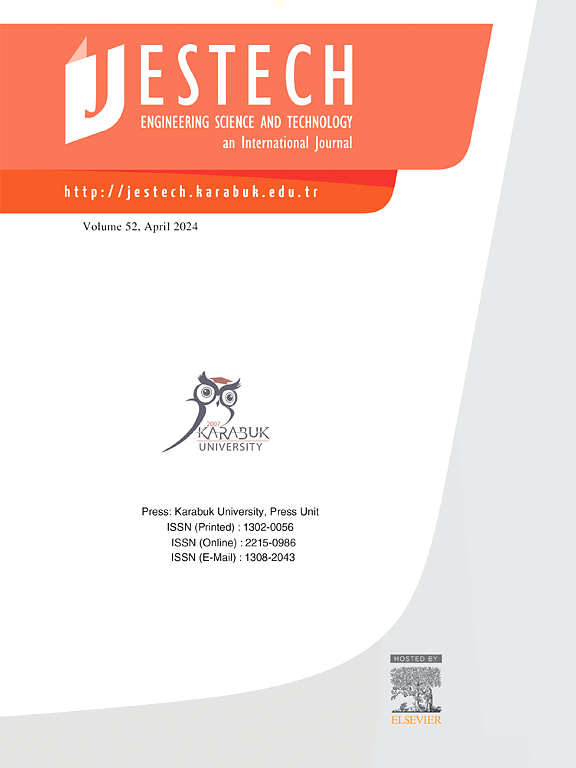Thermo-hydrodynamic and exergy optimization of a photovoltaic thermal (PV/T) air collector using NSGA-II
IF 5.1
2区 工程技术
Q1 ENGINEERING, MULTIDISCIPLINARY
Engineering Science and Technology-An International Journal-Jestech
Pub Date : 2025-03-08
DOI:10.1016/j.jestch.2025.102030
引用次数: 0
Abstract
This study investigates the hydrodynamic, thermal, and exergy performances of a photovoltaic-thermal (PV/T) air collector by examining four geometric and hydrodynamic variables. The Non-Dominated Sorting Genetic Algorithm (NSGA-II) optimization method, combined with the finite volume method, is employed to identify and analyze the optimal configuration in comparison to the initial design. Unlike prior studies that optimize isolated design parameters, this work presents a comprehensive multi-objective optimization strategy, concurrently minimizing pumping power while maximizing first- and second-law efficiencies. Three distinct single-objective optimizations were also conducted to minimize pumping power, maximize first-law (thermal) efficiency, and enhance second-law (exergy) efficiency, exploring various geometric and operational parameters. Analysis of variance (ANOVA) results reveal that airflow rate and air channel height significantly influence pumping power, while the number of fins and airflow rate have the most substantial impact on thermal and exergy efficiencies. The single-objective optimization results indicate a 28 % enhancement in thermal efficiency and an 18 % improvement in exergy efficiency, while hydrodynamic performance sees a significant 98 % reduction. In comparison, the multi-objective optimized configuration—featuring a channel height of 0.088 m, a width of 0.159 m, six fin rows, and an airflow rate of 0.006 kg/s—demonstrates a 30 % decrease in pumping power.
Additionally, it improves first- and second-law efficiencies by 25 % and 11 %, respectively. Furthermore, the average panel surface temperature decreases by 7 °C in this optimized scenario. By systematically optimizing air channel parameters and integrating exergy-based analysis, this study establishes a novel performance enhancement framework for PV/T systems, providing valuable insights for next-generation solar energy applications.
利用 NSGA-II 对光伏热(PV/T)空气集热器进行热流体力学和放能优化
本研究通过检查四个几何和流体动力学变量来研究光伏-热(PV/T)空气集热器的流体力学、热学和火用性能。采用非支配排序遗传算法(non - dominant Sorting Genetic Algorithm, NSGA-II)优化方法,结合有限体积法,与初始设计进行对比,识别并分析最优构型。与先前的研究不同,该研究提出了一种全面的多目标优化策略,在最大限度地降低泵送功率的同时,最大限度地提高第一定律和第二定律的效率。通过探索各种几何和操作参数,进行了三种不同的单目标优化,以最大限度地降低泵送功率,最大限度地提高第一定律(热效率),并提高第二定律(火用)效率。方差分析(ANOVA)结果表明,气流速率和风道高度对抽气功率影响显著,而翅片数和气流速率对热效率和火用效率的影响最为显著。单目标优化结果表明,热效率提高了28%,火用效率提高了18%,而流体动力性能则显著降低了98%。相比之下,多目标优化配置(通道高度为0.088 m,宽度为0.159 m, 6排鳍片,气流速率为0.006 kg/s)的泵送功率降低了30%。此外,它还将第一定律和第二定律的效率分别提高了25%和11%。此外,优化后的面板表面平均温度降低了7°C。通过系统优化风道参数和集成基于火用的分析,本研究为PV/T系统建立了一个新的性能增强框架,为下一代太阳能应用提供了有价值的见解。
本文章由计算机程序翻译,如有差异,请以英文原文为准。
求助全文
约1分钟内获得全文
求助全文
来源期刊

Engineering Science and Technology-An International Journal-Jestech
Materials Science-Electronic, Optical and Magnetic Materials
CiteScore
11.20
自引率
3.50%
发文量
153
审稿时长
22 days
期刊介绍:
Engineering Science and Technology, an International Journal (JESTECH) (formerly Technology), a peer-reviewed quarterly engineering journal, publishes both theoretical and experimental high quality papers of permanent interest, not previously published in journals, in the field of engineering and applied science which aims to promote the theory and practice of technology and engineering. In addition to peer-reviewed original research papers, the Editorial Board welcomes original research reports, state-of-the-art reviews and communications in the broadly defined field of engineering science and technology.
The scope of JESTECH includes a wide spectrum of subjects including:
-Electrical/Electronics and Computer Engineering (Biomedical Engineering and Instrumentation; Coding, Cryptography, and Information Protection; Communications, Networks, Mobile Computing and Distributed Systems; Compilers and Operating Systems; Computer Architecture, Parallel Processing, and Dependability; Computer Vision and Robotics; Control Theory; Electromagnetic Waves, Microwave Techniques and Antennas; Embedded Systems; Integrated Circuits, VLSI Design, Testing, and CAD; Microelectromechanical Systems; Microelectronics, and Electronic Devices and Circuits; Power, Energy and Energy Conversion Systems; Signal, Image, and Speech Processing)
-Mechanical and Civil Engineering (Automotive Technologies; Biomechanics; Construction Materials; Design and Manufacturing; Dynamics and Control; Energy Generation, Utilization, Conversion, and Storage; Fluid Mechanics and Hydraulics; Heat and Mass Transfer; Micro-Nano Sciences; Renewable and Sustainable Energy Technologies; Robotics and Mechatronics; Solid Mechanics and Structure; Thermal Sciences)
-Metallurgical and Materials Engineering (Advanced Materials Science; Biomaterials; Ceramic and Inorgnanic Materials; Electronic-Magnetic Materials; Energy and Environment; Materials Characterizastion; Metallurgy; Polymers and Nanocomposites)
 求助内容:
求助内容: 应助结果提醒方式:
应助结果提醒方式:


